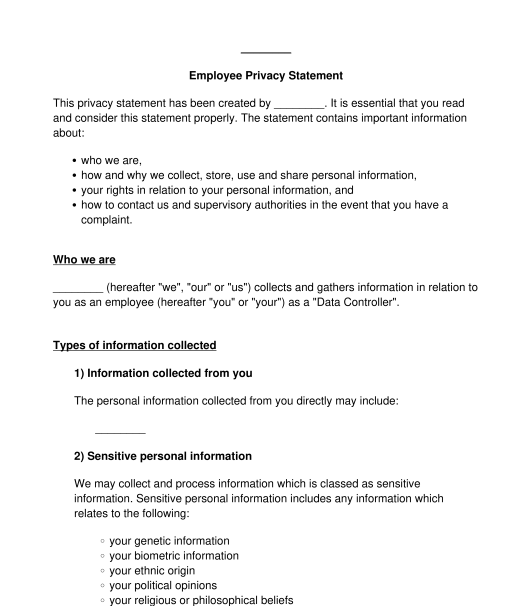 18/09/2025
18/09/2025

Answer a few questions and your document is created automatically.

Your document is ready! You will receive it in Word and PDF formats. You will be able to modify it.

 18/09/2025
18/09/2025
 Word and PDF
Word and PDF
 6 to 9 pages
6 to 9 pages
An employee privacy policy is a document that is used by an employer in the United Kingdom in order to notify its workforce of its data processing procedures.
Yes. An employer has a duty to communicate information to employees regarding the use and processing of their personal data in a clear and accessible format. The simplest way to meet this requirement is to have a written policy document.
Personal data means any information relating to an identified or identifiable natural person (a data subject). It is therefore information from which a person may be identified directly or indirectly. Examples of personal data include a person's:
If an employer formally recognises a trade union or staff association, they may wish to consult and agree on the terms of the policy with them. If a collective agreement is in place between the employer and the relevant union or association it may be a requirement to consult with them about the policy and/or agree upon the terms with them. A collective agreement is a written contract that is negotiated between a union and an employer on behalf of its union members.
It is not necessary to sign the privacy policy. Employees should be notified of the existence of the policy and it should placed in an easily accessible location so that employees can find it.
A privacy policy can remain in place indefinitely. However, it is important to make sure that the policy is reviewed and kept up to date, as appropriate.
In particular, an employer should ensure the policy is updated if it changes the way in which it collects, stores, shares or uses personal information. The employer should also ensure that the policy is generally updated and reviewed at regular intervals to ensure that the legal content is kept up-to-date. Typically, a policy of this nature will be reviewed at least annually.
An employee may also hold other policy documents which should be read in conjunction with a privacy policy such as:
A privacy policy will include information about:
The main legal provisions which apply to a privacy policy are:
You fill out a form. The document is created before your eyes as you respond to the questions.
At the end, you receive it in Word and PDF formats. You can modify it and reuse it.
Employee Privacy Policy - Template - Word & PDF
Country: United Kingdom